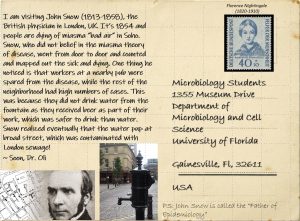ELN & Projects
Global Public Health Project (GPHP)
Before we get started with the public health projects I want you to step back and reflect, what is "Global Public Health"? How does it affect you and the world? What do you know about changes in the world? How is and where is the "third world"? How has life expectancy changed and how has the number of children per women changed over the last 50-100 years? All factors that are important when we talk about public health.
Do you remember the story how John Snow pinned down the London Cholera epidemic? The photo on the right are UF students on the study abroad trip "Medicine, Microbiology and Health" in front of the London School of Hygiene and Medicine.


Before we get started I want you to do two things (in sequence)
1. Check out the Gapminder website and see if you need to upgrade your worldview
2. Listen to the "Global Health Primer" I recently recorded
3. Reflect on what public health means to you and if you have time read the book "Factfulness" by Hans Rosling, the late Swedish physician and public health expert.
Now move on to think about a topic that relates to public health you would like to explore in more depth for your project.
There are few STEM science classes where you can chose your own topic for a project or dig deeper into your passions or pet peeves and share your results with your peers engaging in interesting and controversial discussions. Make sure you are creative in how you convey the message, try to engage your audience and be intentional how you present facts, data and controversial issues.
Choose your topic
This is your first project for the class and you can work in groups up to 4 people. You will submit your topic - and get it approved by your TA/instructor - before you begin working on the project, then you will create a presentation, a skit, a video, a TED like talk, or whatever works for you to get the message across. Below are some tips to help you create a successful presentation.
Choose a topic that interests you and that’s of current relevance. and then start your research! Topics can be as variable as bioremediation to global microbial literacy, Mediterranean diet and the gut microbiome or GMOs in agriculture. Some instructor may chose a theme and have more limited topic choices.
Access OpenStax:
LEARNING GOALS
At the end of this activity, students will be able to…
- Understand why public health is important to understand the global impacts of microbiology
- Define how public health and public health laboratories are important for health outcomes
- Analyze primary and secondary literature to provide recent evidence and support for your topic
- Show and analyze data, trends, changes over time
- Evaluate skills and tools to enhance your effectiveness of strategic communication
Your Public Health Project
- Choose a topic that interests you OR something you have never heard about but sounds intriguing and that’s of current relevance.
- Your topic can be anything from the Mediterranean diet to bio-remediation of oil spills. Your choice!
- Make sure you are choosing project you have never heard of, you are passionately interested in or joining a group because you don't know what to do 🙂
- Include data, numbers, changes over time, $$$ about your topic to persuade your audience that it is important
- BE CREATIVE. Here are just a few ideas that will help to make your project entertaining.
-
- Interview and expert in the field and make it part of your presentation
- Have your group present two different controversial sides of the topic
- Create a video on your topic. It doesn’t have to be long, but can provides some entertainment and makes it more interesting.
- Make a song about your topic and perform it for the class.
- Create a game for the class to play after you present the information on your topic.
- Incorporate informative videos or fun facts about your topic.
- Show numbers, who is affected, how many?
- Make a visual display - infographic
- Write or publish an article for the general public
- Back up your arguments with solid facts but you can also highlight non scientifically correct resources
-
3. Make sure you emphasize why your audience should care?
-
-
- Why should your peers care about the topic you are talking about and listen to you?
- If appropriate provide consumer advice for your peers about products, advertisement, check food labels, additives, etc.
-
For all projects:
-
- Describe current research that is going on which involves your topic
- Any current news involving your topic
- Future implications and big picture
- What is your take home message?
- Describe current research that is going on which involves your topic
Summary: there are NO fixed rules. Be CREATIVE, make it memorable and interesting!
Submit your public health project and the research you have done for the project in canvas.
REAL-WORLD APPLICATION
Presenting about a topic that is of interest and convincing the general public and your peers to care is DIFFICULT. There are many strategies and told for strategic communication and story telling you may want to look into. I am sure you have watched some TED talks? How do they get the message across so that people are mesmerized?
There are many resources for perfecting your story telling skills and learn how to give a talk like presenting at TED, there is presentation ZEN, really think about how to convey your message that people become passionate about what you are talking about!
This persuasive story telling skill is going to be essential for ANY job you will pursue, whether you tell your patients about a disease they have, or you give a scientific presentation at an international conference, or if you talk your family and friends about COVID and why it is important to wear masks or explain the principles of the new vaccines.
Learn how to communicate your point as a story and not as a combatant, none one the other side will listen! Check the resources below
ELN REFLECTION
Make sure you add your preparation and work on your project to your ELN and
For each presentation you listen to, write a brief summary
- Brief summary of each presentation (include, who gave the presentation, topic and main points made)
- Points that can be improved or were confusing
- Score from 1-10 (10 is the best) for each
- Visuals
- Topic explanation
- Novelty, current research, own thoughts and interpretation
ABOVE AND BEYOND
Strategic communication resources
- Presentation Zen: 10 tips for Improving Your Presentations Today

